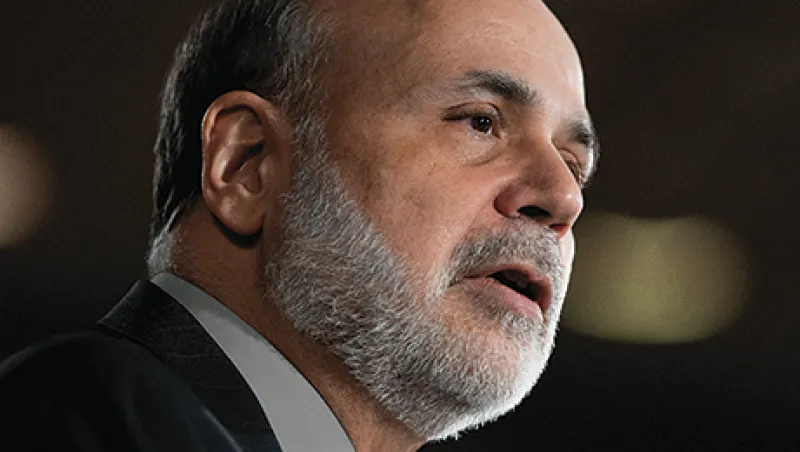Seven years after the financial crisis brought the world to the brink of disaster, the interventions by the U.S. Federal Reserve Board and the Department of the Treasury continue to stoke resentment. But former Fed chair Ben Bernanke has no regrets. “We were trying to protect the financial system from collapse because we knew — and the facts would bear us out eventually — that if the financial system implodes, the economy will not be far behind,” he tells Institutional Investor.
Bernanke, who headed the U.S. central bank from 2006 to 2014, is now a distinguished fellow in residence with the economic studies program at Washington-based think tank the Brookings Institution. In an effort to set the record straight, the man who played the most critical role in taming the crisis recently embarked on a tour for his new book, The Courage to Act: A Memoir of a Crisis and Its Aftermath.
In the book Bernanke, 61, recounts his break with the Republican Party, describing himself these days as a moderate independent. Having been appointed by former president George W. Bush to succeed Alan Greenspan, he writes of his frustration with GOP attacks on the Fed: “It seemed to me that the crisis had helped to radicalize large parts of the Republican Party.”
According to some critics the Fed should have raised interest rates sooner to contain the U.S. housing bubble, the bursting of which provoked the financial crisis. Many contend that the central bank is now fueling yet another bubble with zero rates.
Bernanke doesn’t comment on the policies of his successor, Janet Yellen, but he rejects his critics, insisting that monetary policy was appropriately focused on helping the economy recover from the 2001 recession and avoiding deflation risks. Between 2004 and 2006 the Fed hiked rates from 1.25 percent to 5.25 percent.
“My view of the housing bubble is that to the extent government policy was involved in it, it was primarily failures of regulation rather than monetary policy,” he says. “The Fed, along with other bank regulators, didn’t do enough to prevent bad mortgage lending.”
The central bank did too much to save Wall Street from itself, detractors charge. In March 2008 the New York Fed extended JPMorgan Chase & Co. $13 billion to lend Bear Stearns so it could stay afloat long enough to be acquired by JPMorgan, plus $29 billion to buy toxic assets from the investment bank, which was reeling from plunging values of its subprime mortgage holdings To provide this funding, Bernanke and his colleagues chose what he calls the “Hail Mary” option, invoking Section 13(3) of the Federal Reserve Act for the first time since the Great Depression.
Compiling a playbook of short-term lending options to fight panic was an important development at the Fed, says David Wessel, director of the Hutchins Center on Fiscal and Monetary Policy at Brookings. “It’s kind of amazing Bernanke got the job at the time he did” because he brought crucial insights from his study of the role of monetary policy in the Depression, Wessel says. One key lesson from that event: “The arteries of the economy were clogged with the carcasses of dead banks,” he explains. “[The Fed’s] inability to deal with that stopped the economy from recovering.”
Justifying the Bear Stearns rescue to the public was no easy task, Bernanke concedes. “From the point of view of people on Main Street who don’t understand the connection between finance and the broader economy, to them, this was just helping Wall Street without helping them.”
The Fed stared into the abyss during the week of September 15, 2008, Bernanke recalls, when Lehman Brothers Holdings went bankrupt and American International Group was poised to follow suit. In a much-derided decision, the bank gave no emergency funding to Lehman, but it bailed out AIG with an $85 billion line of credit. Although the insurer had enough collateral in the form of its many subsidiaries, the risk was that the value of those divisions would plummet if the holding company failed. Still, the Fed “saw no alternative” but to proceed with the bailout, Bernanke says.
Higher servicing costs owing to regulation and capital requirements have shifted much of the mortgage origination market away from regulated institutions to nonbank lenders that are subject to fewer rules. To avoid another crisis, it was important for the banking system to have adequate capital and strong oversight, Bernanke says. “But I agree that to the extent credit extension is moving outside the banking system and into the shadow banking system, regulators need to pay close attention to that,” he says. “The Dodd-Frank reforms and other reforms give them the authority to do that.”
Bernanke believes lawmakers have fallen short in other ways, though. He says he’s puzzled by the U.S. government’s strategy of penalizing institutions rather than individuals for wrongdoing connected to the crisis. “I think in many cases it would have been better if the Department of Justice had pursued individual cases and looked for individual mistakes or individual malfeasance,” Bernanke argues. “That would have given us greater clarity on what actually happened, as well.”






